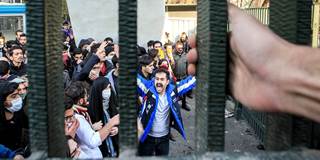Iran's protests, fueled by the rising cost of living and widening economic and social disparities, have quickly morphed into a repudiation of the regime itself. While much of the anger has been directed at the conservative clerical establishment, reformists have as much at stake as their hardline rivals.
LONDON – The rapid spread of civil unrest in Iranian towns and cities that began in late December has taken nearly everyone – President Hassan Rouhani’s reform-minded government, many citizens, and observers – by surprise. Starting in Mashhad, a large religious city in the country’s northeast and a stronghold of Rouhani’s conservative foes, the protests engulfed a number of smaller towns with a speed and ferocity that few could have predicted.
The protests, fueled by the rising cost of living and widening economic and social disparities, quickly morphed into a repudiation of the regime itself. While much of the anger has been directed at the clerical establishment led by Iran’s Supreme Leader, Ayatollah Ali Khamenei, reformists have as much at stake as their hardline rivals.
Iranian reformists are not accustomed to being targets of popular frustration, as they are now. In the country’s presidential elections, political reformers have repeatedly channeled popular discontent into promises of a more hopeful future. That historic role is at odds with reformers’ current responsibility to restore law and order to Iran’s urban areas.

LONDON – The rapid spread of civil unrest in Iranian towns and cities that began in late December has taken nearly everyone – President Hassan Rouhani’s reform-minded government, many citizens, and observers – by surprise. Starting in Mashhad, a large religious city in the country’s northeast and a stronghold of Rouhani’s conservative foes, the protests engulfed a number of smaller towns with a speed and ferocity that few could have predicted.
The protests, fueled by the rising cost of living and widening economic and social disparities, quickly morphed into a repudiation of the regime itself. While much of the anger has been directed at the clerical establishment led by Iran’s Supreme Leader, Ayatollah Ali Khamenei, reformists have as much at stake as their hardline rivals.
Iranian reformists are not accustomed to being targets of popular frustration, as they are now. In the country’s presidential elections, political reformers have repeatedly channeled popular discontent into promises of a more hopeful future. That historic role is at odds with reformers’ current responsibility to restore law and order to Iran’s urban areas.